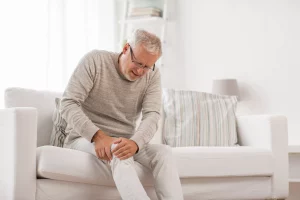Out of Joint: A Look at America’s #1 Cause of Disability
 The most common cause of disability in the United States, arthritis impacts approximately 58.5 million American adults—that’s nearly one in four Americans—according to the Centers for Disease Control and Prevention (CDC). Despite its prevalence, arthritis is often misperceived as a disease only impacting the elderly. Challenging this common misconception is data from the CDC which indicates that more than half (57.3%) of American adults suffering from arthritis are, in fact, between the ages of 18 years and 64 years.
The most common cause of disability in the United States, arthritis impacts approximately 58.5 million American adults—that’s nearly one in four Americans—according to the Centers for Disease Control and Prevention (CDC). Despite its prevalence, arthritis is often misperceived as a disease only impacting the elderly. Challenging this common misconception is data from the CDC which indicates that more than half (57.3%) of American adults suffering from arthritis are, in fact, between the ages of 18 years and 64 years.
What is Arthritis?

A disease of the joints, arthritis causes inflammation in and the breaking down of your joints, which are the points where your bones meet and move. More than 100 different types of arthritis exist—with each form causing some degree of swelling, pain, stiffness, tenderness, and decreased range in
motion. Some types of arthritis are caused by natural wear and tear, while others result from autoimmune diseases or inflammatory conditions.
The two most common types of arthritis you’ll encounter are osteoarthritis and rheumatoid arthritis. Both forms of the disease impact the joints, but in different ways. Osteoarthritis causes the breaking down of your joint cartilage, which is the smooth, hard tissue that covers the ends of your bones where they come together to form a joint. Although osteoarthritis can damage any joint, you are most likely to experience the disorder in your hands, knees, hips, and spine.

Rheumatoid arthritis causes your immune system to attack your joints. It begins by attacking the lining of your joints and can eventually lead to the destruction of the cartilage and bone within your joint. At first, rheumatoid arthritis affects your smaller joints—those in your hands and feet. Later stages of rheumatoid arthritis find symptoms spreading to your wrists, knees, elbows, hips, shoulders, and ankles. The effects of rheumatoid arthritis are not limited to your joints; the disease often damages several body systems such as the skin, eyes, lungs, heart, and blood vessels.
Arthritis Signs & Symptoms
Arthritis symptoms vary depending upon the type of arthritis affecting your joints. While some symptoms are mild and temporary, others are more severe and constant—with the most serious forms of arthritis resulting in chronic, debilitating pain.
The four classic symptoms of arthritis are pain, swelling, stiffness, and reduced range of motion. Arthritic pain greatly varies—from acute and sudden to mild and fleeting. It may present itself when you are at rest or when you are moving, and pain may affect a concentrated part of your body or several different parts. Swelling is another common symptom, and occurs around the affected joint or joints. If your swelling lasts for more than three days or occurs more than three times each month, a doctor’s visit is in order. The third classic symptom, stiffness, is often most evident during movement after you’ve been in one position for a long time, such as getting up from your bed in the morning or rising from a desk seat after a long meeting. Finally, when you experience each of these symptoms—pain, swelling, and stiffness—you are much more likely to reduce your joint’s range of motion due to discomfort.
Long thought to be caused by the natural, gradual wearing down of cartilage, arthritis is now linked to several external factors such as injury, which can initiate chronic cartilage breakdown and obesity, which can exacerbate joint pain by adding stress to the region. Genetics and gender also come into play—with some types of arthritis hereditary and more likely to affect a particular gender.
Living with Arthritis

Although there is no cure for arthritis, with the right measures, arthritic pain won’t keep you from living a healthy, active lifestyle. One of the most effective ways to manage arthritis pain is with exercise. Regular exercise not only helps maintain joint function, it also relieves stiffness and reduces pain and fatigue. In addition to regular exercise, a diet rich in whole grains, leafy greens, berries, and proteins like salmon has proven effective in supporting healthy joints. Finally, there are a number of treatments and therapies—such as physical therapy, therapeutic massage, and acupuncture—that may benefit joints and systems impacted by certain forms of arthritis. To learn more about how Anodyne Pain & Wellness Solutions can treat your arthritis and support your journey to healthy living, visit anodynepain.com today.
Related Articles
Whether you’re struggling to diagnose a chronic pain condition or you’re pursuing wellness treatments to stay healthy and feel great, we’re here to support you at every step of your health care journey.


